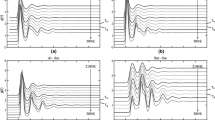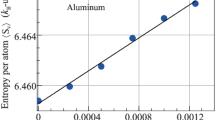Summary
A simple quasi-static model is used to calculate the potential energy field for a probe Al ion sitting in the liquid phase in the neighbourhood of the melt-crystal interface in aluminum at 933 K. Calculations make use of anab initio potential, already described in the literature, which well reproduces several bulk properties. The calculated field exhibits a complex structure; a relevant feature of it consists in the appearance in the liquid of potential minima which correspond either to substitutional or to interstitial positions in the growing lattice.
Riassunto
Il campo di potenziale a cui è sottoposto uno ione di alluminio nella regione liquida vicina all’interfaccia solido-liquido di Al a 933 K è stato calcolato usando un semplice modello microscopico quasi statico. Il calcolo si basa su un potenziale calcolato da principi primi, già descritto in letteratura, che riproduce bene diverse proprietà del liquido e del solido. Il risultato principale è l’esistenza di un campo di potenziale strutturato nel liquido vicino all’interfaccia. Questo campo presenta dei minimi che corrispondono a posizioni sostituzionali od interstiziali nella regione di crescita del reticolo.
Резюме
Предлагается простая квазистатическая модель для вычисления поля потенциальной энергии для зондирующего Al иона, находящегося в жипкой фазе вблизи границы плавящегося кристалла Al при 933 К. При вычислениях используется потенциал, уже описанный в литературе, который хорошо воспроизводит некоторые объемные свойства. Вычисленное поле имеет сложную структуру, характерной особнностью которой является появление в жидкости потенциальных минимумов, которые соответствуют либо положению внедрения или положению замещения в растущей решетке.
Similar content being viewed by others
References
J. D. Weeks andG. H. Gilmer:Adv. Chem. Phys.,40, 157 (1979).
C. L. Cleveland, U. Landman andR. N. Barnett:Phys. Rev. Lett.,49, 790 (1982).
F. F. Abraham andJ. Q. Broughton:Phys. Rev. Lett.,56, 734 (1986).
M. Rasolt andR. Taylor:Phys. Rev. B,11, 2717 (1975).
L. Dagens, M. Rasolt andR. Taylor:Phys. Rev. B,11, 2726 (1975).
G. Jacucci, R. Taylor, A. Tenenbaum andN. Van Doan:J. Phys. F,11, 793 (1981).
D. J. W. Geldart andR. Taylor:Can. J. Phys.,48, 167 (1970).
A. Miotello, A. Tenenbaum andL. F. Donà dalle Rose:Nuovo Cimento D,7, 854 (1986).
C. J. Smithells:Metals References Book, 5th edition (Butterworths, London, 1976).
M. Hasegawa andM. Watabe:J. Phys. Soc. Jpn.,32, 14 (1972).
R. Car andM. Parinello:Phys. Rev. Lett.,55, 2471 (1985).
W. A. Tiller andJ. W. Rutter:Can. J. Phys.,34, 96 (1956).
Author information
Authors and Affiliations
Rights and permissions
About this article
Cite this article
Tenenbaum, A., Donà dalle Rose, L.F. & Miotello, A. microscopic structure of the solid-liquid interface of aluminum. Il Nuovo Cimento D 9, 141–155 (1987). https://doi.org/10.1007/BF02451172
Received:
Issue Date:
DOI: https://doi.org/10.1007/BF02451172




